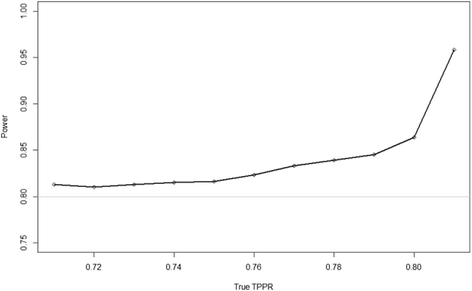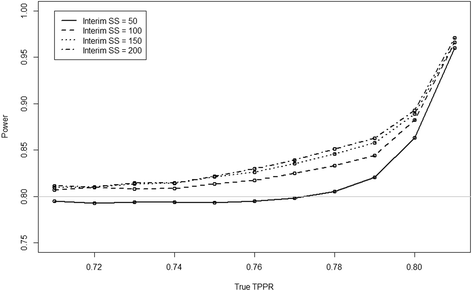Sample size re-estimation in paired comparative diagnostic accuracy studies with a binary response
- PMID: 28705147
- PMCID: PMC5513326
- DOI: 10.1186/s12874-017-0386-5
Sample size re-estimation in paired comparative diagnostic accuracy studies with a binary response
Abstract
Background: The sample size required to power a study to a nominal level in a paired comparative diagnostic accuracy study, i.e. studies in which the diagnostic accuracy of two testing procedures is compared relative to a gold standard, depends on the conditional dependence between the two tests - the lower the dependence the greater the sample size required. A priori, we usually do not know the dependence between the two tests and thus cannot determine the exact sample size required. One option is to use the implied sample size for the maximal negative dependence, giving the largest possible sample size. However, this is potentially wasteful of resources and unnecessarily burdensome on study participants as the study is likely to be overpowered. A more accurate estimate of the sample size can be determined at a planned interim analysis point where the sample size is re-estimated.
Methods: This paper discusses a sample size estimation and re-estimation method based on the maximum likelihood estimates, under an implied multinomial model, of the observed values of conditional dependence between the two tests and, if required, prevalence, at a planned interim. The method is illustrated by comparing the accuracy of two procedures for the detection of pancreatic cancer, one procedure using the standard battery of tests, and the other using the standard battery with the addition of a PET/CT scan all relative to the gold standard of a cell biopsy. Simulation of the proposed method illustrates its robustness under various conditions.
Results: The results show that the type I error rate of the overall experiment is stable using our suggested method and that the type II error rate is close to or above nominal. Furthermore, the instances in which the type II error rate is above nominal are in the situations where the lowest sample size is required, meaning a lower impact on the actual number of participants recruited.
Conclusion: We recommend multinomial model maximum likelihood estimation of the conditional dependence between paired diagnostic accuracy tests at an interim to reduce the number of participants required to power the study to at least the nominal level.
Trial registration: ISRCTN ISRCTN73852054 . Registered 9th of January 2015. Retrospectively registered.
Keywords: Diagnostic accuracy; Interim analysis; Sample-size re-estimation; Sensitivity; Specificity; Study design.
Conflict of interest statement
Ethics approval and consent to participate
REC reference: 10 H1017 8. The original application was made to North West 1 Research Ethics Committee - Cheshire. This committee has subsequently been superseded by the North West - Greater Manchester East Research Ethics Committee. Consent to participate was provided by all participants.
Consent for publication
Not applicable.
Competing interests
The authors declare that they have no competing interests.
Figures
Similar articles
-
Blinded sample size re-estimation in a comparative diagnostic accuracy study.BMC Med Res Methodol. 2022 Apr 19;22(1):115. doi: 10.1186/s12874-022-01564-2. BMC Med Res Methodol. 2022. PMID: 35439947 Free PMC article.
-
Ultrasound, CT, MRI, or PET-CT for staging and re-staging of adults with cutaneous melanoma.Cochrane Database Syst Rev. 2019 Jul 1;7(7):CD012806. doi: 10.1002/14651858.CD012806.pub2. Cochrane Database Syst Rev. 2019. PMID: 31260100 Free PMC article.
-
PET-PANC: multicentre prospective diagnostic accuracy and health economic analysis study of the impact of combined modality 18fluorine-2-fluoro-2-deoxy-d-glucose positron emission tomography with computed tomography scanning in the diagnosis and management of pancreatic cancer.Health Technol Assess. 2018 Feb;22(7):1-114. doi: 10.3310/hta22070. Health Technol Assess. 2018. PMID: 29402376 Free PMC article.
-
Folic acid supplementation and malaria susceptibility and severity among people taking antifolate antimalarial drugs in endemic areas.Cochrane Database Syst Rev. 2022 Feb 1;2(2022):CD014217. doi: 10.1002/14651858.CD014217. Cochrane Database Syst Rev. 2022. PMID: 36321557 Free PMC article.
-
Blinded sample size re-estimation in three-arm trials with 'gold standard' design.Stat Med. 2017 Oct 15;36(23):3636-3653. doi: 10.1002/sim.7356. Epub 2017 Jun 12. Stat Med. 2017. PMID: 28608469
Cited by
-
The diagnostic accuracy of photopic negative responses evoked by broadband and chromatic stimuli in a clinically heterogeneous population.Doc Ophthalmol. 2023 Dec;147(3):165-177. doi: 10.1007/s10633-023-09956-5. Epub 2023 Oct 27. Doc Ophthalmol. 2023. PMID: 37889400 Free PMC article.
-
Randomized test-treatment studies with an outlook on adaptive designs.BMC Med Res Methodol. 2021 Jun 1;21(1):110. doi: 10.1186/s12874-021-01293-y. BMC Med Res Methodol. 2021. PMID: 34074263 Free PMC article.
-
Blinded sample size re-estimation in a comparative diagnostic accuracy study.BMC Med Res Methodol. 2022 Apr 19;22(1):115. doi: 10.1186/s12874-022-01564-2. BMC Med Res Methodol. 2022. PMID: 35439947 Free PMC article.
-
Artificial intelligence enhanced ophthalmological screening in children: insights from a cohort study in Lubelskie Voivodeship.Sci Rep. 2024 Jan 2;14(1):254. doi: 10.1038/s41598-023-50665-5. Sci Rep. 2024. PMID: 38168543 Free PMC article.
-
Practical and analytical considerations when performing interim analyses in diagnostic test accuracy studies.Diagn Progn Res. 2024 Aug 20;8(1):12. doi: 10.1186/s41512-024-00174-4. Diagn Progn Res. 2024. PMID: 39160594 Free PMC article.
References
-
- Swets JA, Pickett RM. Evaluation of Diagnostic Systems. New York: Academic Press; 1982.
-
- Zhou XH, Obuchowski NA, DK MC. Statistical Methods in Diagnostic Medicine. New York: Wiley; 2002.
-
- Gerke O, Vach W, Høilund-Carlsen PF. PET/CT in Cancer - Methodological Considerations for Comparative Diagnostic Phase II Studies with Paired Binary Data. Methods Inf. Med. [Internet]. 2008 [cited 2014 Oct 15];470–9. Available from: http://www.schattauer.de/index.php?id=1214&doi=10.3414/ME0540. - PubMed
Publication types
MeSH terms
Grants and funding
LinkOut - more resources
Full Text Sources
Other Literature Sources
Medical



